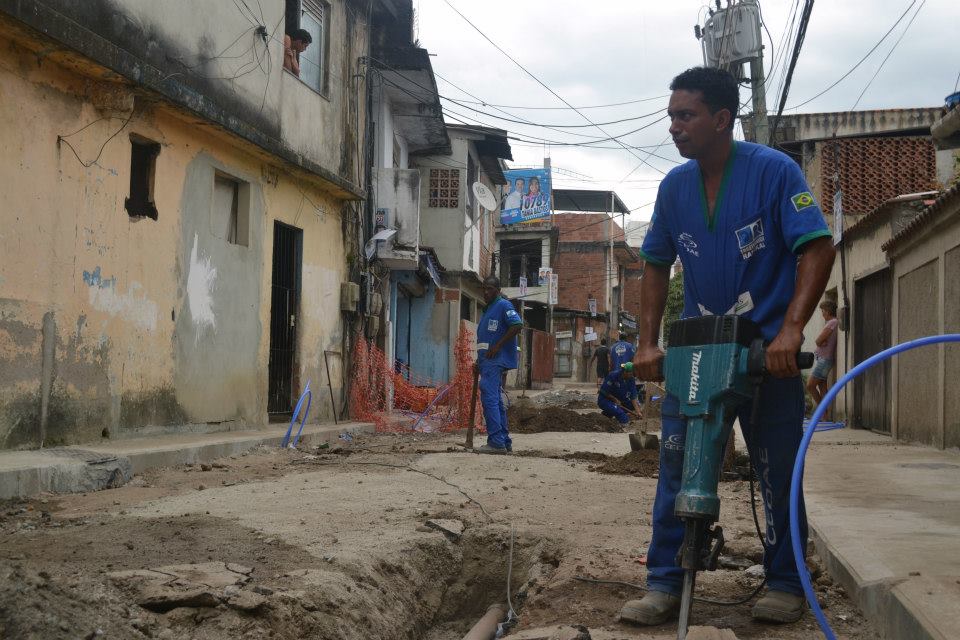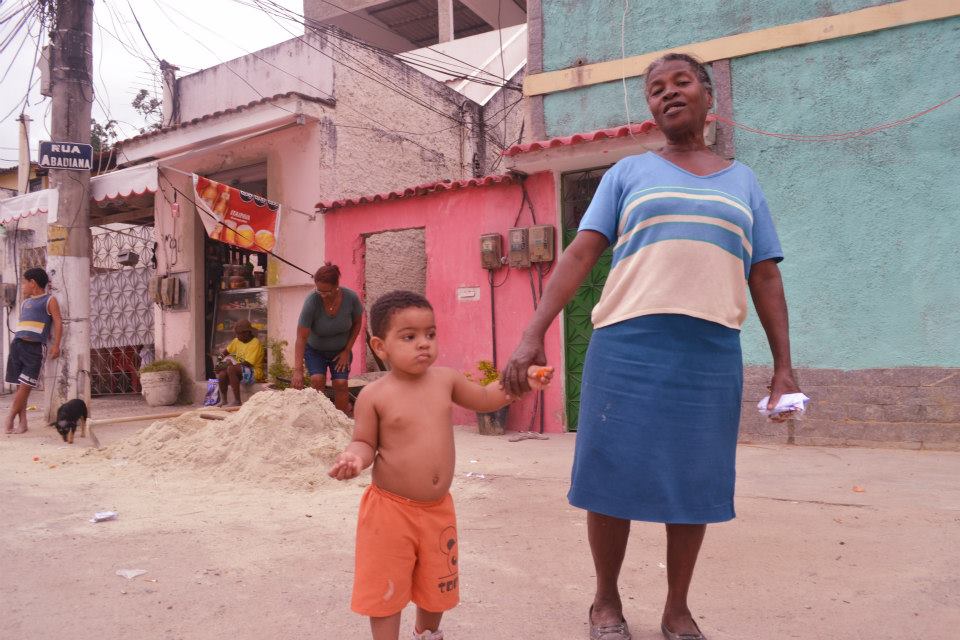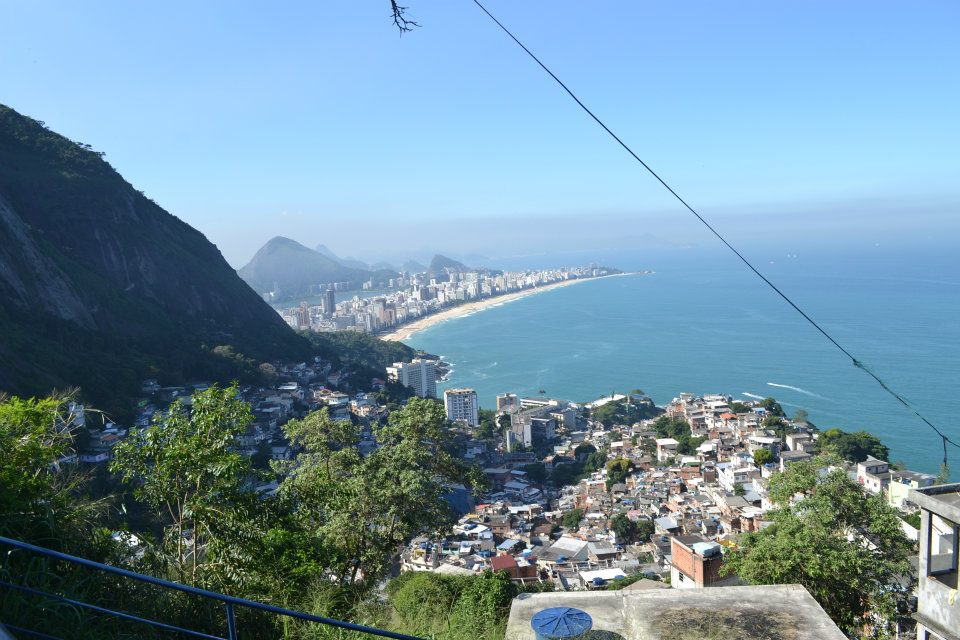
The logo of the 2016 olympics shows three figures and reflects the shape of the mountain Pão de Açucar. From the International Olympic Committee (public domain).
The Turning Point
A new optimism spread throughout Brazil in the wake of the International Olympic Committee’s 2009 decision to hold the 2016 Olympic Games in Rio de Janeiro. The city of Rio de Janeiro, a global destination for tourism, had been caught in a slump during the previous decades. Replaced by São Paulo as the country’s economic engine and displaced by Brasilia as the national capital, Rio was stripped of much of its distinction and left with socio-economic stagnancy that had consigned it to a position among the world’s most troubled cities.
In bidding for the Games, Rio de Janeiro showcased its recent economic growth, the promise of social development, and the mythical image of the cidade maravilhosa (marvelous city), whose much-serenaded coastline has lit imaginations the world over. Designation as the site for the 2016 Olympic Games held the promise of a turning of the tide for Rio. President Luiz Inacio “Lula” da Silva proclaimed this a moment of validation for the country:
Today I’ve felt prouder of being Brazilian than on any other day. Today is the day that Brazil gained its international citizenship. Today is the day that we have overcome the last vestiges of prejudice against us. I think this is a day to celebrate because Brazil has left behind the level of second-class countries and entered the rank of first-class countries. Today we earned respect. The world has finally recognized that this is Brazil’s time. We’ve proven to the world that we are citizens, too.
Winning the right to stage the Olympic Games brought both opportunities and challenges for Rio de Janeiro. Unprecedented federal investment directed at new infrastructure and public safety interventions poured into the city. These changes were meant not only to make the city ready to receive visitors from around the world, but also to build an environment favorable to social change for the city’s poor.
As of fall 2012, four years before the mega-event, diverse initiatives are already under way, but unfortunately, conflicts have emerged between the government and those who were supposed to benefit most from Rio de Janeiro’s makeover. Among the issues are land ownership and participation of residents in decisions affecting the future of communities within the city.
Construction
A wave of infrastructure programs have been initiated at various levels of government, powered by the promise of social integration in a city which has been characterized by extreme differences between the “haves” and the “have-nots.” The work of UPP Social is to be supported by the Morar Carioca (Live in Rio) program, which promises to provide complete urban services for all of the city’s hundred-plus favelas by 2020. This is an extension of the Favela-Bairro (Favela-Neighborhood) integration program of the 1990s and early 2000s. It seeks full participation from favela residents in delineating priorities for improvement in their own communities. For instance, meetings are being held in the favela of Pica-Pau, Cordovil to discuss the needs of the community. In the favelas of Curicica in the West Zone, government officials are going door-to-door to conduct interviews with residents. Babilonia, a neighbor of Copacabana, is already seeing the creation of community gardens and public housing guided by the preferences of its residents.

Asa Branca, a favela in Rio’s Northern Zone, undergoes pre-Olympic construction. Photograph courtesy of Rexy Josh Dorado.
One of the most interesting results of the intense focus on construction in favelas is what architects and urban planners are learning. Generations of favela residents have used creative problem solving to accomplish the informal growth of their communities. Sustainability enthusiasts believe that, in comparison with traditional communities, the organic structure of favelas would make them easier and more economical to “upgrade” to meet 21st century ecological standards.
Urban renewal in the favelas has just begun, and only time will tell whether it can deliver results deserving of the people’s hopes. In the meantime, it is possible to analyze the impact that pre-Olympic investments have made so far. These include the Growth Acceleration Program (PAC) that is taking shape in Rocinha which has established a public library, a sports center, and a $15-million footbridge at the favela’s entrance. A new metro line provides faster transportation from the neglected areas of the West Zone to opportunities in the South Zone. Finally, a teleferico (cable car) now stretches across a portion of Complexo do Alemão’s hillside. It facilitates transportation and provides revenue through tourism.
Although these new construction projects have received much publicity and acclaim, the contributions they make to improvement of the quality of life are not unqualified. Rocinha’s open sewer system, just five minutes from its flashy entrance, continues to threaten the health of its residents. The city government rejected a design for the metro line that would have served a needier population and opted instead for an extension of the existing metro lines. Only a small fraction of Alemão’s population report benefiting from the cable car system, whose route was constructed with little community consultation.
Some have called efforts to transform the favelas “maquiagem” (makeup). These critics denounce the preoccupation with political imagery—a message of a bright future for those living in poverty—which conceals a darker reality of unfulfilled promises.
Expulsion
The Porto Maravilha (Marvelous Port) project tackles the issue of improving Rio’s image. More specifically, it seeks to revitalize the long under-utilized port area in the downtown Centro district, creating a more attractive cultural landmark in its place. The grand plan for the Porto has sought to integrate the existing cultural life within this urban space. In one notable example, Mayor Eduardo Paes stepped in to halt the eviction of a group of artists who had renovated and were occupying an abandoned chocolate factory, stating:
The evacuation of the various art spaces in the old Bhering factory in the Port zone doesn’t make any sense, even the small number that made the property go to auction. Let’s stop this absurdity. This is exactly the purpose that we want the region to fulfill.
In the same area, however, 30 percent of the residents of the hillside community of Providencia came home to find their houses marked for eviction. In their place, the government plans to build a cable car system that is, on paper, meant to serve the community’s transportation needs. This is a questionable claim, considering the fact that 70 percent of the houses at the top of the hill have been scheduled for removal. Having built their homes over generations, most residents would prefer to stay. They have resisted eviction with artwork and written complaints. In addition, they have brought in experts to refute the government’s claim that their houses are unsafe. But eviction notices remain on the facades of these houses and demolition continues at a steady pace in spite of dissent.

This family, like many others in the community of Abadiana, is under threat of eviction. Photograph courtesy of Rexy Josh Dorado.
Providencia is not the only community targeted for demolition. Along the edges of the future Olympic park, residents of favela Vila Autodromo have found their land rights at risk because the government plans to move them out to make room for Olympic construction. Residents have mobilized, gaining support from an international following that includes architects who have drawn up a “People’s Plan for Vila Autodromo,” which offers the alternative of integrating the favela into the design of the Olympic park instead of demolishing it.
In Curicica, in the city’s Western Zone, some of the same communities that are looking forward to Morar Carioca upgrades are being threatened with removal due to plans for a TransOlimpica highway that will connect the Southwest regions close to the Olympic site (Barra da Tijuca and Jacarepagua, among others) to another Olympic cluster in the north.
The expulsion of low-income residents from prized land is aided by gentrification, an unintentional side effect of urban renewal and public safety policies. In Rocinha, housing prices were reported to have risen 50 percent within three days of its pacification, an astronomical increase for the 35 percent of the community who were renters. Rocinha’s sister community on the same hill, Vidigal, is being threatened by the same market pressures, as its enviable views of the Ipanema and Leblon coastline become safer and more accessible to outsiders with money to invest.

The view from Vidigal, a favela in the Southern Zone that faces heavy real estate speculation. Photograph courtesy of Rexy Josh Dorado.
Affordable housing is pushed further and further west to cramped public complexes in the “regioes dormitorios” (bedroom communities) of Santa Cruz and Campo Grande that contain few job opportunities and little dignity for those who enjoyed the simple but comfortable housing and strong identity with community that had developed in many favelas. Whether through eviction or rising prices, many of those in Rio’s lower classes are being forced into areas devoid of the advantages of their former communities and infested with armed drug traffickers fleeing the pacification program in the favelas.
The Olympic Games are still four years away, and only after they are over will their impact be fully gauged. At the moment, there is great promise balanced by the threat of grave consequences, and much progress is accompanied by the further marginalization of less favored populations. The same forces of domination that resulted in Rio de Janeiro’s traditional social divisions linger beneath efforts to mitigate them, although an increasing awareness of the value of grassroots participation in the decision-making process stirs hope of a happy ending. There is still time and opportunity to build coalitions and share the writing of the Olympic legacy.
Further Reading
- The site RioOnWatch.org publishes articles about Rio’s development in preparation for the Olympics that fit with its mission of bringing visibility to favela residents and their experiences in such “developments.”
Sources
- Rohter, Larry. Brazil on the Rise: The Story of a Country Transformed. New York: Palgrave Macmillan, 2010.
- Williamson, Theresa. “In the Name of the Future, Rio Is Destroying Its Past.” The New York Times, 12 August, 2012.
- — “A Missed Opportunity in Rio.” The New York Times, 3 April, 2012.
